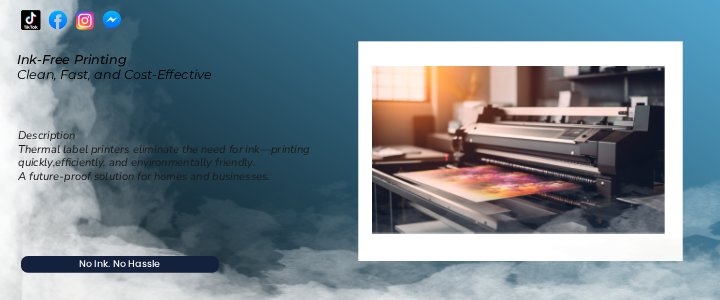Benefits of Thermal Label Makers
In today’s fast-paced world, printing efficiency matters more than ever. Whether you’re organizing files, labeling packages, or running a small business, the demand for quick and clean printing has made thermal label makers a popular choice. Unlike traditional printers that rely on ink or toner, thermal label makers use heat-based printing technology to produce sharp, durable labels — completely ink-free.
This innovation not only simplifies labeling but also offers practical benefits for both home and business users. Let’s explore why thermal printing is quickly becoming the smarter, cleaner, and more sustainable choice.
1. What Is Thermal Printing?
Thermal printing is a process that uses heat to transfer or activate an image onto special thermal paper or label materials. There are two main types of thermal printing technologies:
- Direct Thermal Printing: Uses chemically treated labels that darken when heat is applied. No ink, toner, or ribbon is required.
- Thermal Transfer Printing: Uses a heat-sensitive ribbon to transfer ink onto the label, offering longer durability for harsh environments.
For most label makers, direct thermal printing is the preferred method because it’s simple, low-maintenance, and perfectly suited for everyday use.
2. The Advantages of Ink-Free Printing
Thermal label makers are redefining the way we think about printing. Here are some of their key advantages:
No Ink or Toner Costs
Traditional printers rely on consumables like ink cartridges and toner refills — which can be expensive and messy. Thermal printing completely eliminates these recurring costs. The only thing you need is thermal paper or label rolls, making it a more budget-friendly option in the long run.
Low Maintenance
Because there are no moving ink parts or printheads to clean, thermal label makers require very little upkeep. This means fewer breakdowns, less maintenance time, and more consistent printing performance.
Compact and Portable
Many thermal label makers are small and lightweight, making them ideal for mobile use — whether you’re labeling inventory in a warehouse, shipping products, or organizing home supplies.
Fast and Reliable Printing
Thermal printing produces labels almost instantly. There’s no drying time, smudging, or ink spreading. The result is crisp, professional-looking labels ready to use immediately.
3. Comparing Thermal Printing vs. Traditional Ink Printing
To better understand the difference, here’s a quick comparison between thermal and conventional printing methods:
| Feature | Thermal Printing | Ink/Toner Printing |
|---|---|---|
| Ink or Toner Required | No | Yes |
| Maintenance Needs | Low | High |
| Print Speed | Fast | Moderate |
| Cost Over Time | Low | High (due to consumables) |
| Best Use | Labels, shipping tags, receipts | Documents, photos |
This comparison shows why many businesses are switching to thermal printing for labeling and logistics — it’s cleaner, faster, and more cost-effective.
4. Eco-Friendly Benefits
Ink-free printing also has environmental advantages. By eliminating ink cartridges and toner, thermal label makers reduce plastic waste and chemical pollution. Fewer disposable parts mean fewer materials ending up in landfills.
Additionally, because thermal printers consume less power and require fewer replacement parts, they help lower your overall carbon footprint. For eco-conscious users or companies aiming for greener operations, thermal printing is a step in the right direction.
5. Ideal Use Cases for Thermal Label Makers
Thermal label makers aren’t just for businesses — they fit seamlessly into many everyday applications:
- Home organization: Label containers, cords, or pantry items.
- Small businesses: Print product labels, barcodes, or price tags.
- Warehouses and shipping: Generate fast, durable shipping labels.
- Education and office use: Create clear, professional file tags and folders.
Whatever your needs, thermal printing offers efficiency and clarity in every label.
6. Limitations to Consider
While thermal printing offers many benefits, it’s worth noting a few limitations:
- Direct thermal labels may fade over time, especially when exposed to sunlight or heat.
- They’re best suited for short- to medium-term labeling rather than long-term archiving.
However, for most practical labeling tasks — especially in offices, warehouses, or home environments — these limitations are minimal compared to the convenience and savings.
Conclusion
As technology advances, printing continues to evolve beyond traditional ink and toner systems. Thermal label makers represent this shift — offering fast, efficient, and eco-friendly solutions for modern labeling needs.
With their ink-free design, low maintenance, and cost savings, thermal printers make everyday tasks smoother and more sustainable. Whether you’re labeling packages, products, or personal items, thermal printing delivers clarity and convenience that’s hard to beat.
In a world that values simplicity and sustainability, ink-free printing truly marks the future of labeling technology.



